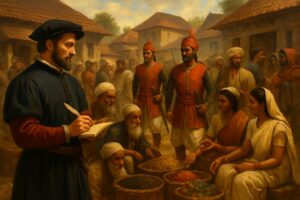Royal Food Security: Inside the Elaborate Protocols of Mughal Imperial Dining
*Recently discovered European accounts reveal the extraordinary security measures and culinary sophistication that surrounded the Mughal emperors’ meals*
By Historical News Team | Sanskrit Saga
Long before modern food safety protocols or security measures for world leaders, the Mughal emperors of India had developed an elaborate system of culinary security and ceremony that would rival today’s presidential protocols.
European travelers who visited the Mughal court in the 17th century documented these fascinating dining practices in detail, providing a rare glimpse into the daily life of emperors like Akbar and Shah Jahan.
## The Royal Kitchen: A High-Security Operation
According to Father Monserrate, a Jesuit priest who visited Emperor Akbar’s court, the imperial kitchen operated under strict regulations that governed every aspect of food preparation and service.
“His [Akbar’s] tables were very sumptuous, often consisting of forty dishes,” Monserrate wrote. “They were brought to the chamber covered and wrapped in linen cloths which were tied up and sealed by the cook.”
This wasn’t merely about presentation—it was a sophisticated security system designed to prevent poisoning, a constant concern for rulers throughout history.
## A Culinary Procession
The journey of food from kitchen to emperor involved a ceremonial procession that would make modern presidential security details nod in appreciation.
Once prepared, dishes were sealed by the “Mir Bakawal” (head of the kitchen) and wrapped according to their containers—gold and silver dishes in red cloth, china in white. A procession then formed, with mace-bearers walking ahead to clear the path, followed by “bakawalchis” (specialized food servants) carrying the sealed dishes.
“These dishes were carried up to the doors of the dining chamber by youths with servants walking alongside,” Monserrate observed. “At the door, they were taken over by the eunuchs. At the door of the chamber, the seals were broken, and the food tasted by the eunuchs before being placed on the table.”
This tasting ritual—similar to the role of modern “food tasters” for some world leaders—provided a final security check before the emperor began his meal.
## The Dastarkhan: Setting the Royal Table
Sebastien Manrique, another European traveler, noted that Emperor Shah Jahan typically dined with Asaf Khan (a prominent noble) inside the “harem” (private quarters). The dining area featured sheets with fine materials spread over the floor, called “dastarkhan”—a tradition that continues in South Asian dining today.
“It was customary for the emperor to set aside a portion of food for the poor before beginning his meal,” Manrique wrote, highlighting the ritual charity that accompanied imperial dining.
## A Department of Dozens
The imperial kitchen was no small operation. According to Abul Fazl’s “Ain-i-Akbari,” a contemporary administrative account of Akbar’s empire, the kitchen employed numerous specialized servants under the supervision of a head chef.
“The imperial kitchen looked after every matter of kitchen,” notes historian Safia Shahzad in her analysis of these accounts. “Many servants were employed for this department who were supervised by head [chefs]. Many precautions were taken in preparing and presenting meals.”
## Fusion Cuisine: The Original Culinary Melting Pot
Perhaps most significantly for culinary history, these accounts document how Mughal cuisine represented one of history’s great culinary fusions—blending Persian, Central Asian, and Indian traditions into what we now recognize as the foundation of modern North Indian cuisine.
The travelers described the use of exotic spices, elaborate cooking techniques, and the presentation of dozens of dishes at a single meal—a testament to the culinary sophistication of the Mughal court.
## A Legacy That Endures
The elaborate food culture of the Mughal court didn’t simply disappear with the empire. Many of the dishes, techniques, and even serving traditions documented by these European travelers continue to influence South Asian cuisine today.
From the rich, aromatic biryanis to the tradition of communal dining on a dastarkhan, the culinary legacy of the Mughals remains a living heritage—one that began with those carefully sealed dishes and ceremonial processions in the imperial palace.
*Image: A historical scene depicting the elaborate food procession in the Mughal court, with mace-bearers clearing the way, servants carrying sealed dishes wrapped in colored cloths, and eunuchs testing the food before presenting it to Emperor Akbar, circa 17th century.*

